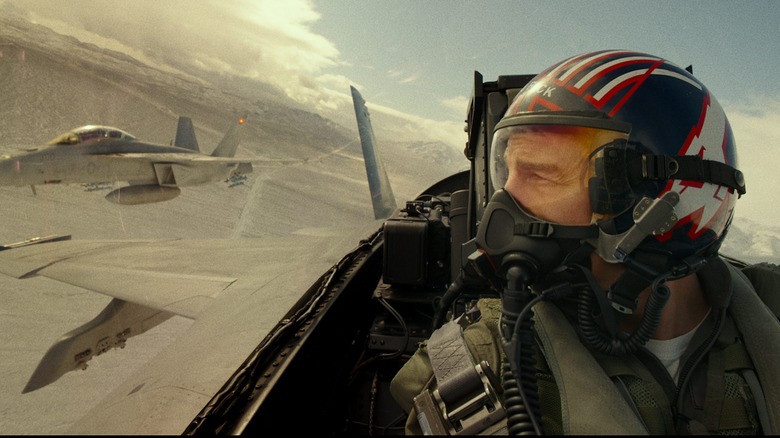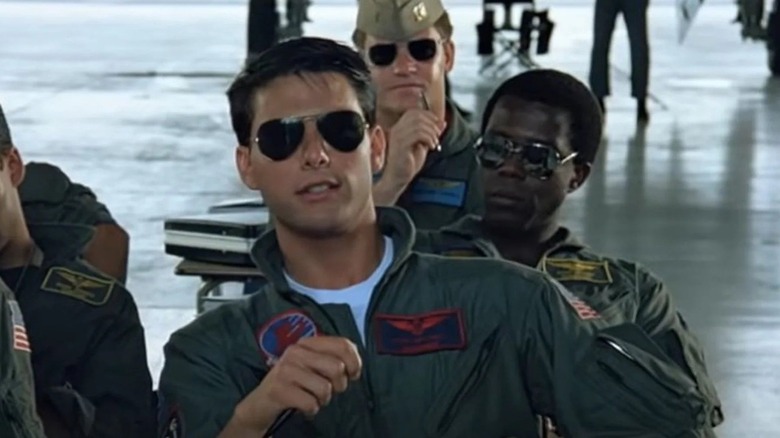An Original Top Gun Editor Helped Sift Through Top Gun: Maverick's Overwhelming Amount Of Footage [Exclusive]
Making a massive action film like "Top Gun: Maverick" requires a meticulous amount of planning and attention to detail. One of the reasons that the blockbuster legacy sequel works so well is the commitment to not have an overreliance on the intrusive digital effects and CGI that dominate most of the big-budget landscape. That choice was decided well before one frame of film was shot, thanks to Tom Cruise's dedication to aviation and the entire field of stunt work over the past 40 years.
When Tony Scott's original "Top Gun" barreled its way into cinemas in 1986, practical effects were still king and audiences connected more with everyday heroes instead of caped crusaders. Scott's trademark visual style and the real-world flying captured by cinematographer Jeffrey Kimball ("The Legend of Billie Jean," "Beverly Hills Cop II") helped wow audiences that had really never seen anything that eye-popping combined with the undeniable star power and magnetism of Cruise.
Inevitably, the decision to capture the kind of death-defying scenes shown in "Top Gun: Maverick" led to shooting an incredible amount of footage that an editor has to sit through and make sense of at some point. Director Joseph Kosinski shot an excessive, almost obsessive amount of footage to ensure that they had everything they needed to blow away the jaded modern audiences of today. Obviously, they succeeded.
There was so much footage, in fact, the original editor of "Top Gun," Chris Levinson ("Enemy of the State"), was ultimately brought on to help make sense of the mountains of film that had been amassed over two years of production.
Recreating the feeling of the original Top Gun
Naturally, bringing on the original editor of Tony Scott's American action classic created a bridge between the two films that helped make the 34-year gap not seem so intimidating. /Film's Jack Giroux spoke with "Top Gun: Maverick" editor Eddie Hamilton about how difficult it was to incorporate the same visual language and recreate the feeling of the original, saying:
"What was interesting is when you realize the textures that [Tony Scott] created for the original 'Top Gun' with the filters that he used on the camera and the choice of lenses, when we were trying to recreate that feeling, we discovered how incredibly difficult it is to create. It gives you an enormous additional level of respect for what that entire team did in 1985 and 1986 when the movie came out."
Scott's films are still so vibrant even today. Working with the original editor of "Top Gun" also gave Hamilton a new appreciation for what they managed to accomplish back then. He continued:
"I got Chris Levinson, one of the editors of the original "Top Gun," who also did "Days of Thunder" and worked with Tony Scott many times, he came on to help me when I was totally overwhelmed with footage for a few months. I got to ask him all my questions about working with Tony Scott. He was a gentleman and obviously a phenomenally good editor."
It's incredible to think of just how much footage Kosinski and his team shot for the film, but it reportedly took an inordinate amount of time to capture anything that could actually wind up in the finished film. Only 30 seconds of usable footage could be salvaged out of a 12 or 14-hour day, on average. Fueling the jets and teaching the actors how to essentially become their own cinematographers, gaffers, and editors also proved to be prohibitively time-consuming.
The more that comes out about the filming of "Top Gun" Maverick," the more of a marvel it becomes that the adventures of Captain Pete "Maverick" Mitchell were ever continued at all. Maybe some of that footage could be used for a third "Top Gun" in the future? Fingers crossed.

